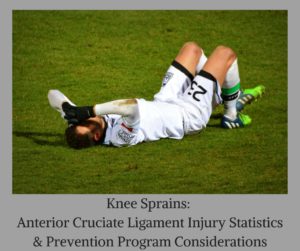
Knee ligament sprains are a common injury – often occurring during sports but also possible through random life calamities like slipping on ice or tripping over the family dog. Ligaments are the fibrous connective tissues that attach bones to other bones. In the case of the human knee, there are 4 large ligaments that attach the upper leg to the lower leg. A sprain is a tear in ligamentous tissue. When a ligament is torn, the joint that it is associated with can become unstable. In the knee, a ligamentous sprain can result In difficulty moving from side to side or stopping and starting A sprain can also cause difficulty with activities like going up and down steps, squatting, or standing on 1 leg. Sometimes, a sprain can heal on its own. This is true if the injured ligament is only partially torn. If a ligament is completely torn through, it will not heal on its own.
One of the knee ligaments, the Anterior Cruciate Ligament (ACL) is the subject of lots of medical attention. Injuries to the ACL occur when the knee is hyperextended –straightened too far, beyond the typical end range of movement. ACL injuries also occur when the bones of the upper and lower leg twist in opposite directions while the foot is planted on the ground. 80% of ACL injuries occur in non-contact situations. The rest occur after a direct blow to the joint.
Did you know that in the United States over 350,000 anterior cruciate ligament reconstruction surgeries are performed? Clearly this is an injury that is impacting public health.
Did you also know that young female athletes are far more likely to suffer this type of injury than their male counterparts? More total injuries are recorded in the United States each year for males, but a higher injury rate per exposure is documented for females. This link is to a 2016 systematic literature review of studies of ACL injury in high-school athletes. These studies estimate that female high-school and collegiate athletes have 9 times and 5 times the risk of injury of their male athlete counterparts
Historically, it has been hypothesized that females are at higher risk for ACL injury because of anatomical factors that are different between females and males, such as the shape of the inside of the knee joint where the ligament attaches and the angle that is formed between the pelvis and the thigh bone. It has also traditionally thought that females are more inclined to have poor knee alignment during jump-landing movements. (If you are interested in more information, this literature review from 2012 contains a nice summary of what is & is not well-supported in current research w/ regard to anatomic and neuromuscular risk factors.)
Because ACL injuries are such a common issue, a lot of work has gone into studying how to prevent this injury from occurring in the first place. The good news is that prevention programs seem to work! This study published in 2017 discusses what is currently known about ACL Injury Prevention Programs. There has been strong evidence that these programs are effective in reducing injury risk for both male and female athletes. Some of the key factors correlating w/ success at injury prevention were 1) starting programs at an early age, 2) focusing on correcting faulty biomechanics (most specifically decreasing poor knee alignment on jump-landings), 3) performing the prevention program activities frequently, and 4) including a variety of exercise types in the program. Different sorts of activities called plyometrics and neuromuscular training are recommended in addition to strength training exercise.
Current physical therapy literature suggests that even though reconstructive surgery for ACL injuries is typically quite successful – the longer-term health of injured knee joints is often compromised after an injury. This literature reports that 79% of patients that have ACL reconstructions ultimately end up with osteoarthritis in the joint. 20% of patients that undergo surgery have a second injury within 2 years. More long-term studies are needed comparing the ongoing health of patients that undergo knee surgery after ACL injury with patients that opt out of surgery. Some current studies like this one suggest that long-term outcomes of patients in both situations (surgical and non-surgical) are similar.
The decision about whether or not to consider surgical treatment after a knee injury is specific to each individual and his or her life circumstances. In all cases, comprehensive rehabilitation through physical therapy is indicated after a knee sprain. Your physical therapist can help you to recover optimal function and activity levels after knee injury. A physical therapist can also help to guide each patient during their individual decision making process about how best to approach post-injury treatment.
If you have questions about knee sprains or how to prevent knee ligament injuries, give your therapist at Symmetry a call. We’d be glad to help you to keep your knee joints healthy!
